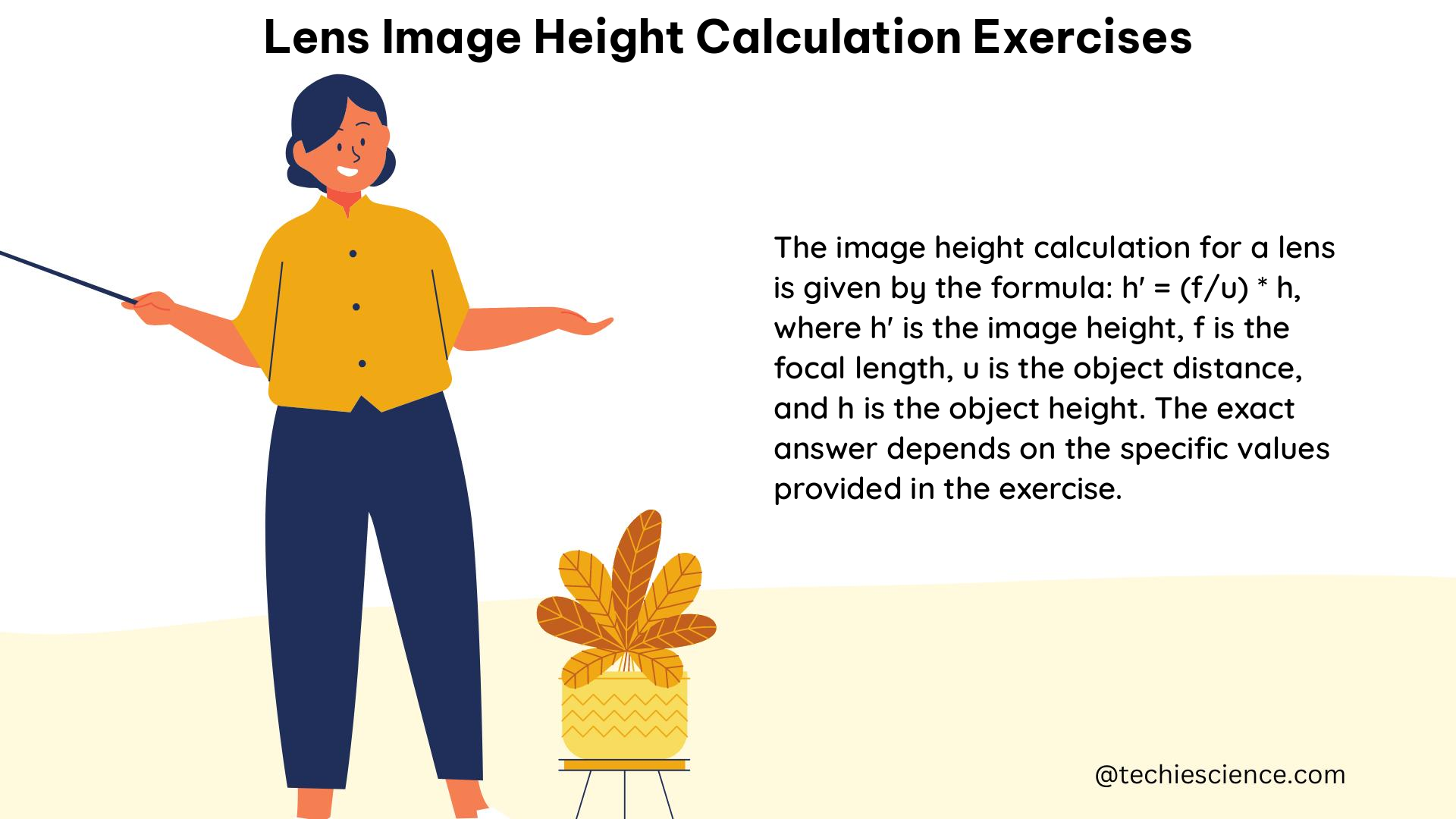Summary
Calculating the image height of an object for a lens is a fundamental concept in optics and geometric ray tracing. This comprehensive guide will walk you through the essential principles, formulas, and examples to help you master this skill. You’ll learn how to determine the height of the unmagnified object, the magnification of the lens, and use these values to accurately calculate the height of the final image. Whether the magnification is positive or negative, this guide will equip you with the knowledge and problem-solving techniques to tackle a variety of lens image height calculation exercises.
Understanding Magnification and Image Height

The key to calculating the image height of an object for a lens is understanding the concept of magnification. Magnification is the ratio of the height of the image to the height of the object, expressed as:
$M = \frac{h_i}{h_o}$
Where:
– $M$ is the magnification
– $h_i$ is the height of the image
– $h_o$ is the height of the object
The magnification can be greater than 1, between 0 and 1, or negative, depending on the characteristics of the lens and the object’s position relative to the lens.
Positive Magnification
When the magnification is positive, the image will be upright and larger than the object if $M > 1$, or smaller than the object if $0 < M < 1$. The image height can be calculated as:
$h_i = M \times h_o$
Negative Magnification
If the magnification is negative, the image will be inverted (upside-down) and virtual, meaning it appears to be behind the lens. The image height can be calculated as:
$h_i = -M \times h_o$
The negative sign indicates the virtual and inverted nature of the image.
Lens Image Height Calculation Exercises
Example 1: Positive Magnification
A 10 cm high candle is placed in front of a lens with a positive magnification of 1.5. Calculate the height of the image.
Step 1: Determine the height of the unmagnified object and the magnification of the lens.
– Object height ($h_o$) = 10 cm
– Magnification ($M$) = 1.5
Step 2: Calculate the height of the image using the formula for positive magnification.
$h_i = M \times h_o$
$h_i = 1.5 \times 10 \text{ cm}$
$h_i = 15 \text{ cm}$
The image height is 15 cm, and the image is upright.
Example 2: Negative Magnification
A 5.0 cm high butterfly is placed in front of a lens with a magnification of -0.50. Calculate the height of the image.
Step 1: Determine the height of the unmagnified object and the magnification of the lens.
– Object height ($h_o$) = 5.0 cm
– Magnification ($M$) = -0.50
Step 2: Calculate the height of the image using the formula for negative magnification.
$h_i = -M \times h_o$
$h_i = -0.50 \times 5.0 \text{ cm}$
$h_i = -2.5 \text{ cm}$
The image height is -2.5 cm, and the image is virtual and inverted.
Additional Lens Image Height Calculation Exercises
Here are some more examples to practice your lens image height calculation skills:
- A 20 cm tall object is placed 30 cm in front of a converging lens with a focal length of 15 cm. Calculate the height of the image.
- A 6 cm high object is placed 10 cm in front of a diverging lens with a focal length of -20 cm. Calculate the height of the image.
- A 12 cm tall object is placed 40 cm in front of a converging lens with a focal length of 20 cm. Calculate the height of the image.
- A 8 cm high object is placed 25 cm in front of a diverging lens with a focal length of -30 cm. Calculate the height of the image.
- A 15 cm tall object is placed 50 cm in front of a converging lens with a focal length of 25 cm. Calculate the height of the image.
Remember to follow the steps outlined in the previous examples, using the formulas for positive and negative magnification as appropriate.
Conclusion
Mastering lens image height calculation exercises is a crucial skill for physics students and anyone working with optics and geometric ray tracing. By understanding the relationship between magnification, object height, and image height, you can accurately predict the size and orientation of the final image for a variety of lens and object configurations.
This comprehensive guide has provided you with the essential principles, formulas, and examples to tackle a wide range of lens image height calculation exercises. Continue practicing these exercises to solidify your understanding and develop your problem-solving abilities in this important area of physics.
References
- Study.com. (2021-11-08). How to Calculate the Image Height of an Object for a Lens – Study.com. Retrieved from https://study.com/skill/learn/how-to-calculate-the-image-height-of-an-object-for-a-lens-explanation.html
- OpenStax. (2016-09-29). 2.4 Thin Lenses – University Physics Volume 3 | OpenStax. Retrieved from https://openstax.org/books/university-physics-volume-3/pages/2-4-thin-lenses
- LWC Physics. (n.d.). Physics – Lens Problems. Retrieved from https://lwcphysics.yolasite.com/resources/lens%20problems%20-%20answer%20key.pdf

The lambdageeks.com Core SME Team is a group of experienced subject matter experts from diverse scientific and technical fields including Physics, Chemistry, Technology,Electronics & Electrical Engineering, Automotive, Mechanical Engineering. Our team collaborates to create high-quality, well-researched articles on a wide range of science and technology topics for the lambdageeks.com website.
All Our Senior SME are having more than 7 Years of experience in the respective fields . They are either Working Industry Professionals or assocaited With different Universities. Refer Our Authors Page to get to know About our Core SMEs.